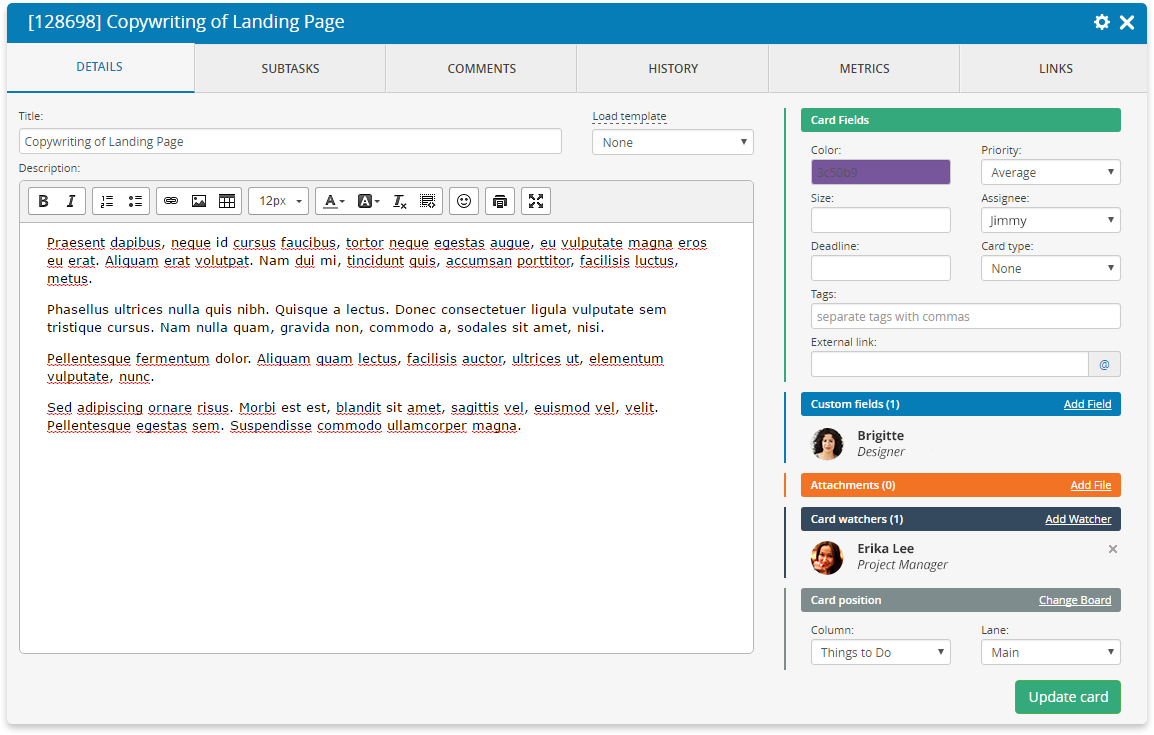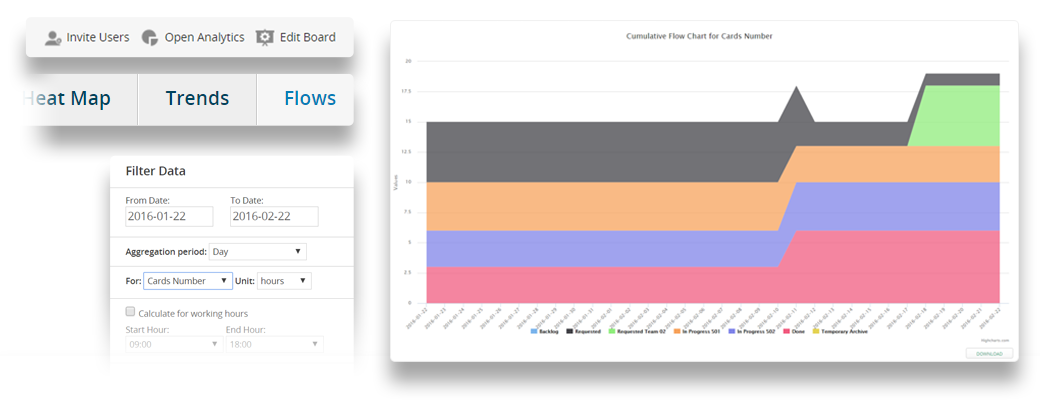No matter the industry you’re working in, if you’re part of the marketing team, then there is a high chance you’re facing the challenge of meeting strict deadlines and executing multifaceted urgent tasks on a regular basis. Each project most likely requires design phases, a separate content generation phase, many involved agents, as well as a very high-stakes sign-off procedure. Even further, because you’re dealing with publicity, any misstep on your team’s part can determine the image of the company. Campaigns, events, media partner communications, and advertising, you name it; all of these must pass through the marketing department in order to become part of an organization’s public strategy.
Luckily, there are ways to visually represent the chaotic marketing process in a unified breakdown of larger goals, their subtasks, and the assignees involved in each step of completion. Breaking down your work creates an organized system of tracking progress from plan development to material distribution on all levels and visualizing your top-level objectives as smaller pieces. There are a couple of methods out there designed to make sure you build your breakdown optimally. The most current one, taking the professional world by storm, is the Japanese Kanban method.
For example, let’s say you’re in the process of creating a Landing Page campaign for a specific product. The phases of your process will look something like this:

How Can You Map Your Work Breakdown on a Kanban Board? And Why?
Unlike teams in the field of software development, marketing teams are only recently beginning to officially adopt a Lean approach to how they structure the way they work. For that reason, mapping an array of tasks connected to a larger project on a Kanban board might seem foreign. However, when executed correctly, in other words, maintaining a system to show relationships between tasks, keeping team and individual Work-in-Progress limits in check and monitoring metrics generated from the regular use of the board visualization, Kanban will prove to be a highly efficient and intuitive method for any process.
One of the most important things to keep in mind when setting up your first Marketing Kanban Board is that the board is meant to reflect your process, it is not meant to dictate the way you do business. In most cases, you won’t have to change many parts of your work process in the beginning in order to achieve a higher level of productivity within your team.
Create a Master Portfolio Board to Track Your Campaigns
Start by creating a master portfolio Kanban board where you can track the status of all the larger campaigns your team is currently working on or has worked on in the past. This board can become a reference for your team to use to track the overall cycle time of an entire campaign and all general information about the process. It’s like a bird’s eye view of the ongoing, completed and upcoming campaigns.

A Daily Work Board to Execute Your Work Breakdown
The daily work Kanban board can track individual campaign breakdowns. Here, one card/ campaign on the portfolio Kanban board gets broken down into many smaller tasks linked together to show how they are connected to each other as derivative tasks of the top-level objective. For example, if the campaign at hand is the building of a landing page, then the work board will show each smaller task related to the creation of the landing page larger task but not the top-level objective itself.
First things first, label the columns and swimlanes on your Kanban board to reflect the stages a task must undergo before it is considered complete in the context of your team and project. Use the Master Marketing board in order to track large-scale objectives such as entire ad campaigns, blog content, media partnerships, and almost anything else that you can’t just one-off and is considered dependent upon a network of other tasks. In the same way, break the daily workflow board into more detailed parts of your process related specifically to one particular campaign that is In Progress.
While the Master Board might have a process as simple as Requested, In Progress, and Done, the daily work board might follow a more detailed structure of column nomenclature:

Ready to Start – Priority tasks, the result of our weekly meetings
In Progress – The tasks here are currently being worked on by the team in some capacity
Review – If some work has been done on the task or the assignee considers it complete but another team member or team lead should take a look at it and offer feedback before it is considered finished
*Tracking Others -depending on whether external parties outside of the team are involved in the given campaign, you might choose to add a tracking others column in order to keep track
Waiting on Parent / Relative – When a task has two aspects requiring the time of two different experts on the team (for example, designer and copywriter) then it will be split into two relative tasks. When the first one is completed but is still waiting on its buddy, this column will be used to show the progress of the connected tasks
Done – move tasks to this column only when all work related to them has been completed
Task Dependencies in the Breakdown
The Initial Breakdown is meant to describe the type of marketing campaign you want to launch and break down the top-level objective into its constituent parts. Mapped on the Kanban board, the breakdown of a single campaign will not be immediately visualized as an essential branch structure. In Kanbanize work breakdown and tracking software, for example, the breakdown of the main task into smaller related pieces can be represented by the linking of tasks based on defined relationships. Tasks on the same level in the breakdown hierarchy will be connected as relatives of each other while larger tasks such as Design of Landing Page will take the role of a parent task to smaller, related tasks, such as Design Edits and 3 Option Pitch.
By creating links between cards to show child, parent or relative relationships, your team can create a hierarchy between the top-level objective and its further breakdown child tasks to be able to track progression. In Kanban terms, you can visualize your work breakdown across the board using the Kanbanize analytics module, which creates a graphical representation of the created relationships to show them in the typical branch structure.

By building links between your tasks, your team is creating a manageable break down structure, the progress of which can be tracked throughout the entire course of the project using your visual board itself, as well as the Analytics and reporting modules you have at your disposal if you’re using Kanbanize.
Assigning Tasks to Individuals, not Groups
Tracking who is responsible for what in the breakdown is often a problem in large marketing teams because, most of the time, more than two people collaborate on a single task. In situations like these, there is a danger of overlooking accountability. That’s why, during the creation of the breakdown, individual bottom-level tasks in the structure get assigned to different members of the team. For example, in the landing page scenario, the finished product will be the result of the efforts of a designer, a copywriter, and a marketing lead. In addition, marketing initiatives, no matter how small, often require a second or third pair of eyes in order to develop fully. In this case, being able to follow the process and track related variables coherently can be useful to any and all of the affiliates.
Using software to create a breakdown of your work means you can assign different permissions and roles to the people who have access to the project board. In the breakdown of the landing page campaign, the copy editor takes the role of the assignee in the tasks related to the 2nd Copywriting stage of the process. Meanwhile, the designer is the contributor to the copywriter as well as the assignee in the first branch of the Landing Page Design process. The watcher on all the cards is the project manager, monitoring the process. Further, each task has individual people accountable for their own piece of the puzzle.

Tracking Your Time Is Everything
Right place, right time. It wouldn’t be too far-fetched to say that those two concepts are the essence of good marketing campaigns. During the course of a campaign, it becomes imperative that a marketing department keeps a strict eye on where their team’s time is going and aim to optimize how it is being spent. The data collected during the course of the building of the campaign is as important as the data collected from the results after its activation. Kanban cards track time for individual tasks and subtasks so you can make estimates about future projects and also carefully track how efficiently the one you’re working on is moving forward.
Considering all the details and manpower that go into completing a work item, cycle time becomes an essential metric within the context of a project of any size. Cycle time is just another way of measuring how long it takes to complete a task – from the moment it goes into the In Progress column to the moment it moves to the Done column. Project budgets are not only calculated based on the financials but also on time as a resource and a commodity.
Monitor time-based metrics in the graphics for cycle time that show you how long it takes your team to complete tasks.
Go one step further to see the Trends and Flows charts that can show you overall trends in your workflow, information about individual criteria or people on the team and any other data, such as cost, that you might be tracking in custom or size fields as part of your breakdown.

Our marketing team hosts weekly meetings during which we generate analytical visualizations of the data we are accumulating on an individual and team basis during our work week and share them with all the people involved for maximum visibility.
Stay Lean. Stay Agile.
By breaking down your marketing campaign on a visual Kanban board and taking a Lean approach to managing its execution, you are not only choosing the optimal approach, you are also taking the dedicated path to actually tracking the way you work so you can get even better at it. These steps towards continually improving the way your team performs are what will set you apart from other marketers aiming for similar results.

Nikolay Tsonev
Product Marketing | PMI Agile | SAFe Agilist certified
Nick is a seasoned product marketer and subject matter expert at Businessmap, specializing in OKRs, strategy execution, and Lean management. Passionate about continuous improvement, he has authored numerous resources on modern-day management. As a certified PMI practitioner and SAFe Agilist, Nick frequently shares his insights at Lean/Agile conferences and management forums.



